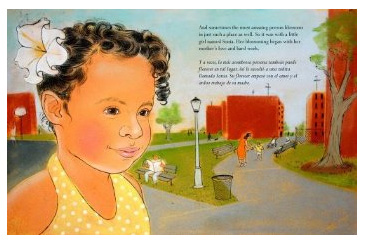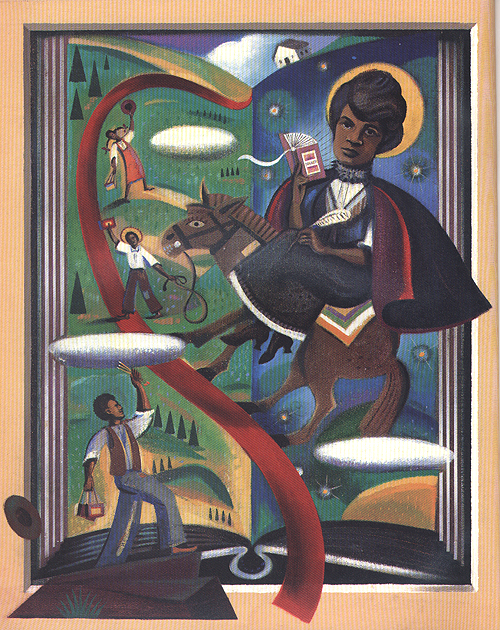When I designed the Newark Public Schools' summer school literacy project for children in primary grades, I gave a lot of thought about how to infuse high quality text into that experience and decided to emphasize the daily interactive read aloud as one important component of the daily learning. Because I am also teaching and coaching in the project, I have the satisfaction of not only designing, but also seeing that work interpreted and enacted with children. I knew without a doubt that I would learn so much and that this partnership would give rise to questions, wonderings, and theories about teaching and learning. I have not been disappointed as I have seen super work being done with regard to vocabulary and text response and this work has prompted my thinking.
Because most of the read aloud texts are meant to be read across multiple days as well as reread, I imagined that teachers might chart the wonderings of students as they talked and might let sit a question of two across several days: a question that the teacher and students would revisit as they reread a given text. Unfortunately, I failed to make that clear in the guide I wrote and so I might be most responsible for what I perceive as an absence. It is the dwelling in ideas that matter so.
 |
| Child's response to what happens at the beginning of The Firekeeper's Son. |
I am going to be paying attention to dwelling in text as I make my way through the next week with the teachers and children. I hope to post another blog in which I follow children's lines of thought that happen apart from the read aloud text and yet is connected to it.
Thinking beyond the read aloud time about the text is an important goal.
Here are some of the texts children are hearing and interacting with this summer.
Kindergarten
- Aruego, Jose. (2002). Weird Friends: Unlikely Allies in the Animal Kingdom. Illustrated by Ariane Dewey. San Diego, CA: Gulliver Books.
- Brenner, Barbara. (1997). Thinking About Ants (big book format). Illustrated by Carol Schwartz. New York: Mondo Books.
- Collier, Bryan. (2004). Uptown. New York: Henry Holt.
- Cotten, Cynthia. (2002). At the Edge of the Woods: A Counting Book. Illustrated by Reg Cartwright. New York: Henry Holt.
- Jenkins, Steve. (2011). Actual Size. New York: Sandpiper.
- Thong, Roseanne. (2000). Round as a Mooncake: A Book of Shapes. Illustrated by Grace Lin. San Francisco, CA: Chronicle Books.

 |
| Illustration by Edel Rodriguez from Sonia Sotomayor: A Judge Grows in the Bronx. |
- Burns, Marilyn. (2008). The Greedy Triangle. Illustrated by Gordon Silveria. New York: Scholastic.
- English, Karen. (2004). Hot Day on Abbott Avenue. Illustrated by Javaka Steptoe. New York: Clarion Books.
- Lunis, Natalie. (1999). A Closer Look (big book format). New York: Newbridge Educational Publisher.
- Park, Linda Sue.(2009). The Firekeeper's Son. Illustrated by Julie Downing. New York: Sandpiper.
- Winter, Jeanette. (2011). The Watcher: Jane Goodall's Life with the Chimps. New York: Schwartz & Wade.
- Winter, Jonah. (2011). Sonia Sotomayor: A Judge Grows in the Bronx: La juez que crecio en el Bronx. Illustrated by Edel Rodriguez. New York: Atheneum Books for Young Readers.
Second Grade
 |
| Claire Nivola's illustration from Life in the Ocean. |
- Chin, Jason. (2009). Redwoods. New York: Flashpoint.
- Elya, Susan Middleton. (2006). Home at Last. Illustrated by Felipe Davalos. New York: Lee & Low.
- Guiberson, Brenda. (2009). Life in the Boreal Forest. Illustrated by Gennady Spirin. New York: Henry Holt.
- Nivola, Clarie. (2011). Life in the Ocean: The Story of Oceanographer Sylvia Earle. New York: Farrar, Straus and Giroux.
- Tate, Bill. (2012). It Jes Happened: When Bill Traylor Started to Draw. Illustrated by R. Gregory Christie. New York: Lee & Low.
 |
| Ida B. Wells by Stephen Alcorn from Let It Shine. |
Third Grade
- Alvarez, Julia. (2002). How Tia Lola Came to (Visit) Stay. New York: Yearling.
- Curtis, Christopher Paul. (2004). Bud, Not Buddy. New York: Laurel Leaf.
- Myers, Walter Dean. (2008). Ida B. Wells: Let the Truth Be Told. Illustrated by Bonnie Christensen. New York:
- Pinkney, Davis Andrea. (2000). Let It Shine: Stories of Black Women Freedom Fighters. Illustrated by Stephen Alcorn. San Diego, CA: Harcourt.
- Weston, Mark. (2008). Honda the Boy Who Dreamed of Cars. Illustrated by Katie Yamasaki. New York: Lee & Low Books.

No comments:
Post a Comment
Note: Only a member of this blog may post a comment.